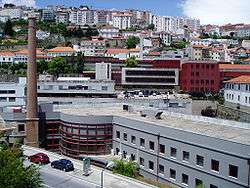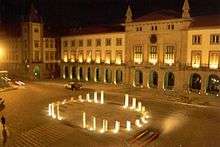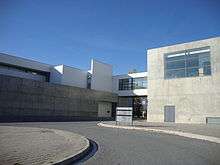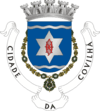Covilhã
| Covilhã | |||
|---|---|---|---|
| Municipality | |||
 | |||
| |||
 | |||
| Coordinates: 40°17′N 7°30′W / 40.283°N 7.500°WCoordinates: 40°17′N 7°30′W / 40.283°N 7.500°W | |||
| Country |
| ||
| Region | Centro | ||
| Subregion | Cova da Beira | ||
| Intermunic. comm. | Beiras e Serra da Estrela | ||
| District | Castelo Branco | ||
| Parishes | 21 | ||
| Government | |||
| • President | Vítor Pereira (PS) | ||
| Area | |||
| • Total | 555.60 km2 (214.52 sq mi) | ||
| Population (2011) | |||
| • Total | 51,797 | ||
| • Density | 93/km2 (240/sq mi) | ||
| Time zone | WET/WEST (UTC+0/+1) | ||
| Website |
www | ||
Covilhã (Portuguese pronunciation: [kuviˈʎɐ̃]) is a city and a municipality in the Centro region, Portugal. The city proper had 34,772 inhabitants in 2001.[1] The municipality population in 2011 was 51,797,[2] in an area of 555.60 km².[3] It is located in the Cova da Beira subregion and the district of Castelo Branco. The municipal holiday is October 20.
Sometimes referred to as town of wool and snow, Covilhã is one of the main urban centres of the historical Beira Interior region. The proximity of the mountains offers dramatic scenery and a great environment for those fond of hiking, camping, mountain climbing and skiing.
History and landmarks

Its history dates back to the days when it was a pre-historical settlement, a shelter for Lusitanian shepherds, and a Roman fortress known as Cava Juliana or Silia Hermínia. The region of Beira Interior, where the city of Covilhã is located, is rich in historical places. Due to its strategic potential, its mountains were used to build castles for both attack and defence purposes. Covilhã was granted foral in 1186 by king Sancho I of Portugal, who also built the castle walls. The old quarters of the city have narrow cobblestone streets; pedestrians are challenged permanently by the ups and downs of most of the streets in the city.
A school-factory was built by Fernando de Meneses, 2nd Count of Ericeira, in 1681. On November 1, 1755, Covilhã was shaken by the forces of the 1755 Lisbon earthquake that destroyed part of Covilhã's castle walls and its large towers. A Royal Textile Factory, was established in the city by the Marquis of Pombal in 1763, and Covilhã was granted city status on 20 October 1870 by king Luís I of Portugal. Along the two streams that cross the city there are still remains of the old textile factories, which bear witness to the unquestionable importance of this industry for Covilhã's economy, once known as the "Portuguese Manchester".
During the first half of the 19th century, the municipality of Covilhã had about 22,000 inhabitants, and in 1930 it nearly reached 50,000 inhabitants. During the 1960s, Covilhã's municipality surpassed 70,000 inhabitants, but the Portuguese Colonial War (1961–1974) and the generalized emigration phenomena of the 1960s to 1980s Portuguese society, its geographical location in the mountainous interior of central Portugal, increasing mechanization and the stagnation of its textile industrial sector, caused a period of decline of its population to nearly 50,000 in the 1990s. A state-run university, UBI - Universidade da Beira Interior, was founded in 1979. The city is still expanding, mainly to the flat part of the valley called Cova da Beira, where some important infrastructures such as the central hospital and the highway are located.
Geography and climate
Covilhã is located in the Centro region, Cova da Beira subregion, in central Portugal; 300 km (186 mi) Northeast of Lisbon, Portugal's capital; 100 km (62 mi) East of Coimbra, the regional administrative centre; and at the bottom of the highest Portuguese mountain range, Serra da Estrela. The city of Castelo Branco is located 50 km (31 mi) to the south of Covilhã and the neighbouring town of Fundão, the largest locality in the vicinities of Covilhã, is 20 km (12.4 mi) also to the south.
The city of Covilhã towers between 450 and 800 metres (1,476 and 2,624 feet) above the sea level, thus the mountain landscape is ever present. The larger municipality has 555.6 km² (214.5 sq mi) of territory and includes several localities distributed across 31 civil parishes.
In the municipality of Covilhã but outside the urban area, Penhas da Saúde is one of its highest points. At 1,500 metres (4,821 ft) high, this village and winter resort is located within the Serra da Estrela Natural Park. The climate in Covilhã is Mediterranean (Csa, according to the Köppen climate classification), moderately cold in the winter and relatively warm in the summer. There is the Vodafone Ski Resort, the only ski resort in Portugal, 20 km (12.4 mi) away from the city, actually in the neighbouring municipality of Seia.
| Climate data for Covilhã, Portugal | |||||||||||||
|---|---|---|---|---|---|---|---|---|---|---|---|---|---|
| Month | Jan | Feb | Mar | Apr | May | Jun | Jul | Aug | Sep | Oct | Nov | Dec | Year |
| Average high °C (°F) | 9.4 (48.9) |
11.2 (52.2) |
13.5 (56.3) |
16.4 (61.5) |
19.2 (66.6) |
24.7 (76.5) |
28.1 (82.6) |
28.4 (83.1) |
24.4 (75.9) |
18.9 (66) |
13.1 (55.6) |
9.8 (49.6) |
18.09 (64.57) |
| Average low °C (°F) | 3.1 (37.6) |
3.6 (38.5) |
5.6 (42.1) |
7.2 (45) |
9.5 (49.1) |
13.5 (56.3) |
15.7 (60.3) |
16.0 (60.8) |
13.9 (57) |
10.5 (50.9) |
6.3 (43.3) |
3.6 (38.5) |
9.04 (48.28) |
| Average precipitation mm (inches) | 162 (6.38) |
150 (5.91) |
109 (4.29) |
90 (3.54) |
76 (2.99) |
49 (1.93) |
10 (0.39) |
10 (0.39) |
47 (1.85) |
105 (4.13) |
146 (5.75) |
128 (5.04) |
1,082 (42.59) |
| Source: Climate-data.org[4] | |||||||||||||
Parishes
Administratively, the municipality is divided into 21 civil parishes (freguesias):[5]
- Aldeia de São Francisco de Assis
- Barco e Coutada
- Boidobra
- Cantar-Galo e Vila do Carvalho
- Casegas e Ourondo
- Cortes do Meio
- Covilhã e Canhoso
- Dominguizo
- Erada
- Ferro
- Orjais
- Paul
- Peraboa
- Peso e Vales do Rio
- São Jorge da Beira
- Sobral de São Miguel
- Teixoso e Sarzedo
- Tortosendo
- Unhais da Serra
- Vale Formoso e Aldeia do Souto
- Verdelhos
Education

Covilhã has a public university - the University of Beira Interior (UBI), which was founded in 1979 and awards all university academic degrees (licentiate "licenciatura", master's and doctorate degrees) in several fields ranging from medicine to mathematics to sports sciences to aeronautical engineering to cinema, among many others.
The municipality of Covilhã has several kindergartens for pre-school children between 3 and 6 years of age, and 3 primary education schools. It has also a number of 2nd and 3rd cycle basic and secondary schools: Escola Secundária Frei Heitor Pinto, Escola Básica dos 2º e 3º ciclos de Tortosendo, Escola Básica Integrada de Sao Domingos, Escola Básica dos 2º e 3º ciclos de Paúl, Escola Básica do 2º ciclo de Pêro da Covilhã, Escola Secundária Campos Melo, Escola Secundária Quinta das Palmeiras, Escola Básica dos 2º e 3º ciclos de Teixoso, Externato de Nossa Senhora dos Remédios and Escola Internacional da Covilhã.
Economy

Major economic activities in the region include textiles, food industry and agriculture. The University of Beira Interior (established in 1979) has a great importance in the city today. The Centro Hospitalar Cova da Beira at Covilhã, a state-run hospital, plays a major role in the region. Covilhã is traditionally a center of wool and textile industries - the university central building was the Royal Textile Factory, established by the Marquis of Pombal in the 18th century. Covilhã has deep industrial roots and is still one of the biggest woollens fabrics producers in Europe. Actually, this industry produces about 40,000 km of fabrics by year, through some textiles companies like Paulo de Oliveira,[6] Penteadora,[7] Tessimax[8] and A. Saraiva, which are supplying of great worldwide textile marks as Hugo Boss, Armani, Zegna, Marks & Spencer, Yves St. Laurent, Calvin Klein and Christian Dior. Tourism is also important, and the city has a role as a winter and mountain resort. Fruit production is important in the region of Cova da Beira, a subregion centered in Covilhã's municipality. Frulact, a Portuguese fruit processing company, has major industrial facilities in the municipality of Covilhã. The city has a science park - Parkurbis - which has attracted several new businesses to the area.

In the mid-2000s, Aleia (a joint-venture of the French companies Dyn'Aéro and Equip’Aéro with the Portuguese Spinworks and Plasdan) announced its intention to produce jet planes of four and six places integrally conceived, constructed and mounted in Covilhã as from 2011. The existence of the University of Beira Interior, with its degree of aeronautical engineering, as well as the local aerodrome contributed for the final decision from Aleia to develop an aerospace industry in the town.[9]
There is a large shopping centre in Covilhã, Serra Shopping,[10] and besides a wide variety of shops, it has hypermarket, four cinemas and many restaurants. Hypermarkets and supermarkets located in the lower part of the town include Continente (inside Serra Shopping), Intermarché, Pingo Doce and Lidl. The Public Market (Mercado Municipal) is another option and an opportunity to buy fresh produce directly from the producers. This town was recently chosen by the biggest telecommunications company in Portugal Portugal Telecom to there build and install one of the biggest Data Centres of Europe, with the capacity to store 30 petabytes of information. The building, opened in September 2013 has a floor area the size of thirteen football pitches. Covilhã is considered now the biggest town in terms of Development and new technologies.
Events and recreation

The City Hall of Covilhã used to be responsible for the cultural programming of one of the movie theatres of the town which has a wide variety of activities throughout the year. Such Movie Theater is now closed. There are also various theatre companies: Teatrubi, ASTA, Teatro das Beiras and Quarta Parede that stage theatre and multimedia productions throughout the year. A theatre festival is organised by a local theatre company, Teatro das Beiras, in November.
The city hosts several choirs and orchestras, like the well-known university choir and the EPABI orchestra, which is based in the building near the public garden (location has now changed to the lower parts of the city), as well as the Orquestra da Banda Filarmónica. At the university there are some student musical groups that reveal the academic environment and celebrate the traditions. They are called Tunas and each one has particular characteristics. Desertuna, Moçoilas Tuna and J’ B’ubi & To Kokuskopus perform throughout the year and welcome everyone that wants to join in and get into the academic spirit. The city hall organizes some musical events, mainly in Teatro Cine, that is located in the heart of the city centre (Pelourinho).
The theatre company GICC (Companhia de Teatro das Beiras), based in Travessa da Tapa, offers professional and high quality performances. There are also various amateur drama groups and dance groups performing in several town locations; ASTA and TEATRUBI are just some examples. Conferences, exhibitions, trade fairs, concerts and other kinds of activities are common in the city. Several trade fairs occur throughout the year in a pavilion belonging to the ANIL – National Association of Textile Manufacturers .
Like other university towns Covilhã has an intense nightlife. Due to the small dimension of the city, it is safe to go out, thus the resulting atmosphere is familiar and there are many pleasant places to have a drink.
A freshmen reception week, organised by the students's union of the University of Beira Interior (Associação Académica da Universidade da Beira Interior), takes place usually in November and includes a parade through town called Latada and several concerts.
Sport
The city has indoor swimming pools and there are also rivers and lakes where swimming is allowed. Facilities for horse riding and karting are also available. The mountain range has excellent conditions for mountain bike, trekking, climbing, skiing and snowboarding. There are tracks with artificial snow that are open all year. There are several gyms offering various services such as sauna, fitness, martial arts, and yoga.
Sporting Clube da Covilhã, a sports club founded in 1923 in Covilhã, is the most important sporting organization in the city. Its football (soccer) team now plays in the secondary national divisions, but in the past played in the top division. It is one of the few clubs of Portugal's interior to have played in the top division of Portuguese football. The football team plays in the Complexo Desportivo da Covilhã, a multi-use stadium able to hold 6,125 people (all-seated).
Transport
The nearest airports are located in Lisbon and Porto. From these two cities, Covilhã can be very easily reached both by train and coach. The railway and coach stations of Covilhã are within a walking distance from one to the other (10 minutes walk). It is also possible to reach Covilhã directly by coach from abroad.
Covilhã is located, less than 300 km from Lisbon and Porto, the two biggest cities in Portugal and just 400 km from the Spanish capital, Madrid. Several national and international bus routes pass Covilhã, so it is easy and practical to reach almost all destinations. To reach Lisbon it takes 3.5h - 4h of journey, by bus or by train. The bus station is situated in the lower part of the city; and the railway station is near, no more than 10 minutes walking. The railway company is CP - Caminhos de Ferro Portugueses and offers various types of services. Inter City (Intercidades) train is recommended to reach Covilhã. There are also car rental companies in the city.
From Covilhã northwards to Guarda trains were operated by diesel motorcars. This scenic stretch of mountainous rural line provides the strategic last leg of the Beira Baixa Railway linking it to Guarda via Belmonte. However, in recent years it has been closed for modernisation and electrification. The partially completed works, originally due for completion in 2011, are sadly still on hold as of 2014 due to serious funding issues associated with the economy. This inconveniently cuts off otherwise direct rail options to destinations north of Covilhã.
A bus network – Covibus – covers all the urban area as well as the outskirts of the city making it easy to travel both within and outside the city limits, although the time between buses is big (not less than 1 hour). Several bus lines serve university buildings. Cabs are also an option. They are painted cream (mostly black these days) and sometimes have a roof-light to identify them. In town they use taximeters, but once outside urban boundaries the service is charged per km.
European Cooperation
- Covilhã is a member city of Eurotowns network[11]
Famous inhabitants
- Pêro da Covilhã (c. 1460 – after 1526), a Portuguese diplomat and explorer.
- Rui Faleiro, Portuguese cosmographer, astrologer, and astronomer who was the principal scientific organizer behind Ferdinand Magellan's circumnavigation of the world.
- José Sócrates, Former Prime Minister of Portugal.
- Eugénia Melo e Castro, (Covilhã, June 6, 1958) Portuguese singer-songwriter.
Politics
The present mayor is Vitor Manuel Pinheiro Pereira, elected by the Socialist Party.
International Relations
Covilhã is twinned with:
Gallery
 View of Covilhã
View of Covilhã Old paved street
Old paved street Ruins of the Tuberculosis Sanatorium
Ruins of the Tuberculosis Sanatorium Street sign linked to town's history
Street sign linked to town's history
See also
References
- ↑ UMA POPULAÇÃO QUE SE URBANIZA, Uma avaliação recente - Cidades, 2004 Archived October 6, 2014, at the Wayback Machine. Nuno Pires Soares, Instituto Geográfico Português (Geographic Institute of Portugal)
- ↑ Instituto Nacional de Estatística
- ↑ Direção-Geral do Território
- ↑ Climate data: Covilhã - Climate-data.org
- ↑ Diário da República. "Law nr. 11-A/2013, pages 552 42-43" (pdf) (in Portuguese). Retrieved 21 July 2014.
- ↑ http://www.paulo-oliveira.pt
- ↑ http://www.penteadora.pt
- ↑ http://www.tessimax.com
- ↑ Covilhã: Aleia vai montar avião até agora vendido em kit e jactos portugueses em 2011, 14th April 2008 (Portuguese)
- ↑ http://www.serrashopping.com
- ↑ "Eurotowns".
External links
 Media related to Covilhã at Wikimedia Commons
Media related to Covilhã at Wikimedia Commons- Covilhã's City Hall official website
- Fórum Covilhã
- Photos from Covilhã
- Covilhã's Blogue

